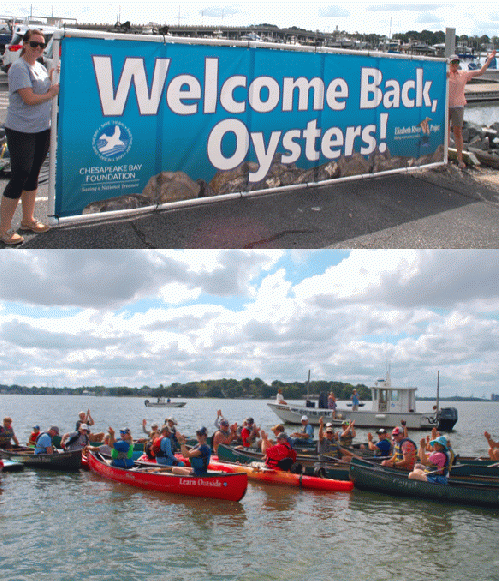
Chesapeake Bay Foundation volunteers welcome the return of the oysters with a flotilla
(Image by CBF Press release) Details DMCA
On Monday, Norfolk's Lafayette River was declared the state's first waterway in the Chesapeake Bay area to reach oyster habitat restoration goals. It was the culmination of community-supported restoration efforts to reduce pollution and restore wildlife that began in the 1990s. Oysters serve as natural filters that clean water, protect shorelines from erosion, and create habitat for fish, crabs, and other aquatic life. Healthy oyster reefs have played a key role in the tributary's revitalization.
Approximately 200 miles long, the Chesapeake Bay is an estuary located between Maryland and Virginia. More than 150 major rivers and streams flow into the Bay's 64,299-square-mile drainage basin, which covers Washington DC and portions of six states, including Maryland, Virginia, New York, Pennsylvania, Delaware and West Virginia.
The 2014 Chesapeake Bay Agreement set a goal of restoring oysters in ten Chesapeake Bay waterways by 2025. Marjorie Mayfield Jackson, Executive Director of the Elizabeth River Project (ERP) said, "It's unbelievable that a part of the Elizabeth River, once presumed dead, now leads Virginia for restoration of the native oyster."
"Chesapeake" comes from the Algonquian, "Chesepiooc." First used as "Chesepiook" by explorers from the Roanoke Colony in about 1585, it is the seventh oldest surviving English place-name in the U.S. The Chesapeake tribe occupied the areas of Norfolk and Virginia Beach near the Lafayette River, so it was fitting that Virginia's first waterway to reach oyster habitat restoration goals was declared on Indigenous Peoples Day. (Indigenous Peoples Day replaces Columbus Day in several states; MN, AK, VT, and OR , along with dozens of other cities around the US. The update was made in honor of First Americans who were on the continent long before Columbus, and who suffered deeply as a result of his "discovery.")
As part of the celebration, project partners led by Elizabeth River Project (ERP) and the Chesapeake Bay Foundation (CBF), as well as residents and other officials, formed a flotilla of boats, kayaks, and paddleboards to plant the final oysters on restored reefs just off the Hermitage Museum and Gardens in Norfolk, VA.
According to the CBF, "Regular surveys of Lafayette reefs show they are thriving, reaching levels well above the density goal of 50 oysters per square meter. Biological sampling has discovered that these reefs are home to at least 25 different species of fish, including seahorses, red drum, striped bass, and speckled trout. Surveys and monitoring the health of Lafayette River oyster reefs will continue in the years to come. Lessons learned here will help inform work on other Virginia tributaries targeted for oyster restoration."

About the Chesapeake Bay Foundation
The Chesapeake Bay Foundation has improved the Bay's overall health since its low in 1983, reversing more than 300 years of decline. Their 2012 State of the Bay report showed the Bay's health improved by 14 percent since 2008.
CBF's Clagett Farm is designed to be a model for how to use truly sustainable farming methods. In addition to teaching students and fellow farmers there, CBF operates a Community Supported Agriculture (CSA) program.
CBF's Litigation Department uses carefully chosen legal action to advance the restoration and protection of the Chesapeake Bay, its rivers, lakes, and streams. As a result, there is an historic and legally binding agreement and plan to remove the Bay from the federal "impaired waters" list. This groundbreaking plan is called the Chesapeake Clean Water Blueprint, and it's the first of its kind.
CBF offers award-winning educational programs to more than 25,000 students each year. To date, more than 1.5 million students of all ages have been through one of CBF's 15 study centers.
CBF has also restored more than 9,000 acres of wetlands and nearly 30,000 acres of forested riparian buffer on agricultural lands in Maryland, West Virginia, Virginia, and Pennsylvania by planting more than 3.3 million trees.
CBF was founded in 1967.





